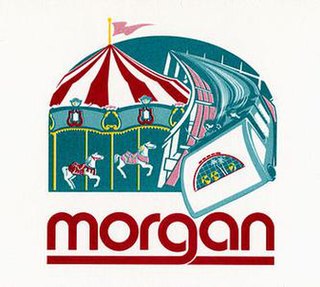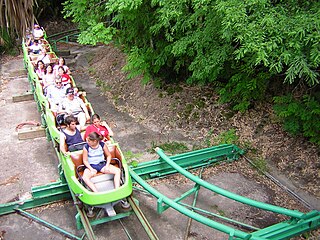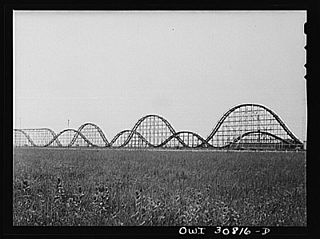
Six Flags AstroWorld, also known simply as AstroWorld, was a seasonally operated amusement park in Houston, Texas. Owned and operated by Six Flags, the park was situated between Kirby Drive and Fannin Street, directly south of I-610. The park opened on June 1, 1968, and was developed originally and constructed as part of the Astrodomain, the brainchild of local philanthropist and former Houston mayor Roy Hofheinz, who intended it to complement the Astrodome. The Hofheinz family sold AstroWorld to Six Flags in 1978.

A stand-up roller coaster is a roller coaster where passengers aboard a train stand throughout the course of the ride. The first manufacturer to employ the format was TOGO, a Japanese company that converted two traditional roller coasters in 1982 to stand-up configurations. Arrow Dynamics followed suit in the United States the following year with their own conversion. The first roller coaster designed from the ground up as a stand-up coaster was King Cobra, built by TOGO, which opened at Kings Island in 1984. Intamin and Bolliger & Mabillard (B&M) have also designed stand-up models beginning in the 1990s, with the latest opening in 2023 as Pipeline: The Surf Coaster in SeaWorld Orlando.

Arrow Dynamics was an American manufacturing and engineering company that specialized in designing and building amusement park rides, especially roller coasters. Based in Clearfield, Utah, the company was the successor to Arrow Development (1946–1981) and Arrow Huss (1981–1986), which were responsible for several influential advancements in the amusement and theme park industries. Among the most significant was tubular steel track, which provided a smoother ride than the railroad style rails commonly used prior to the 1960s on wooden roller coasters. The Matterhorn Bobsleds at Disneyland, built in 1959, was Arrow's first roller coaster project.

A shuttle roller coaster is any roller coaster that ultimately does not make a complete circuit, but rather reverses at some point throughout its course and traverses the same track backwards. These are sometimes referred to as boomerang roller coasters, due to the ubiquity of Vekoma's Boomerang coaster model.

A suspended roller coaster is a type of steel roller coaster in which the car hangs from the bottom of the rolling stock by a pivoting fulcrum or hinge assembly. This allows the car and riders to swing side to side as the train races along the track. Due to the swing designs, these roller coasters cannot invert riders.

Texas Cyclone was a wooden roller coaster at the defunct Six Flags AstroWorld in Houston, Texas. Designed by Don Rosser and William Cobb, it was manufactured by Frontier Construction Company and opened to the public on June 12, 1976. Well-known for its airtime, the roller coaster was 93 feet (28 m) tall, 3,180 feet (970 m) long, and had a ride time of two minutes and fifteen seconds. Texas Cyclone was modeled after the original Coney Island Cyclone, which AstroWorld had originally intended to purchase and move to their park before realizing the process would be too expensive.

Iron Dragon is a suspended roller coaster located at Cedar Point in Sandusky, Ohio. Built in 1987 by Arrow Dynamics, it is located in the Millennium Midway section of the park.

Ninja is an Arrow Dynamics steel suspended roller coaster located at Six Flags Magic Mountain in Valencia, California. It is the fastest roller coaster of its kind in the world, joint with Vortex at Canada's Wonderland, both with top speeds of 55 mph.

The Bat was a suspended roller coaster located at Kings Island amusement park in Mason, Ohio. Designed by Arrow Development, it was billed as the "first of its kind" in the world when it opened to the public on April 26, 1981. The suspended coaster concept was a radical departure from traditional roller coaster design, where guests ride below the track instead of above. Previous attempts to build coasters that hang from the track were unsuccessful and date as far back as the early 20th century. Arrow solved issues by utilizing modern technology in the design, including its tubular steel track developed in 1959 for Disneyland's Matterhorn Bobsleds.

Viper was a steel roller coaster located at Six Flags AstroWorld in Houston, Texas. Manufactured by Anton Schwarzkopf, the Looping Star model opened in 1989. It consisted of a single loop and was demolished with the closing of Six Flags AstroWorld on October 30, 2005. It had previously operated at Six Flags St. Louis, where it was known as Jet Scream from 1981 to 1988.
Hanna-Barbera Land was a theme park based on the cartoons of the Hanna-Barbera animation studio. It was located in the Spring, Texas, United States, north of Houston, and operated for the 1984 and 1985 seasons. After the park's closure following the 1985 season, the rides were sold and the land was reused as a water park, which is now operating as Six Flags Hurricane Harbor SplashTown.

Big Bad Wolf was a suspended roller coaster in the Oktoberfest section of Busch Gardens Williamsburg. Designed by Arrow Dynamics, the roller coaster opened to the public on June 15, 1984. The ride was in service for more than 25 years before closing permanently on September 7, 2009. The footers, queue line, and station were re-purposed for Verbolten, a roller coaster that was introduced in 2012.

D. H. Morgan Manufacturing, later simply known as Morgan, was a manufacturer of roller coaster trains, custom amusement rides, roller coasters, children's rides and other amusement devices. Founded in 1983, the company was originally headquartered in Scotts Valley, California. In 1991, the company moved to La Selva Beach, California, and into a new 55,000-square-foot indoor manufacturing facility. That facility was later increased to 75,000 square feet. The company produced a variety of rides from 1983 until 2001, but is probably best known for its steel hyper coasters.

Batman The Escape was a stand-up roller coaster located at Six Flags AstroWorld in Houston, Texas, United States. Manufactured by Intamin, the ride featured one inversion and originally opened as Shockwave at Six Flags Magic Mountain in 1986. After briefly operating at Six Flags Great Adventure, it was moved a second time to AstroWorld, where it reopened in 1993 as Batman The Escape. The coaster operated there until the park's permanent closure in 2005. The track was eventually moved to Six Flags Darien Lake, placed into storage, and never reassembled.

Ednör – L'Attaque is a steel inverted roller coaster at La Ronde in Montreal, Quebec, Canada. Built by Vekoma, it is a standard 689-meter Suspended Looping Coaster (SLC). It debuted in 1999 as Serial Thriller at Six Flags AstroWorld in Houston, Texas. Following the closure of AstroWorld in 2005, Serial Thriller was dismantled and moved to Six Flags Great Escape and Hurricane Harbor in Queensbury, New York. After sitting idle in New York for four years, it was relocated to La Ronde and opened for the 2010 season.

Serpent was a steel roller coaster at Six Flags AstroWorld. It was built by Arrow Dynamics in 1969, which made it the park's first roller coaster and the last junior mine train made by Arrow Dynamics. After AstroWorld closed at the end of the 2005 operating season on October 30, 2005, the ride was demolished.

Thunder River is a river rapids ride located at two American amusement parks. The first opened in 1980 at Six Flags AstroWorld in Houston, Texas, which was the first of its kind in the world. The popularity led to other similar installations at various Six Flags theme parks throughout the 1980s. Only two with this name remain. One currently operates at Six Flags Over Georgia in Austell, Georgia; the other operates at Six Flags St. Louis in Eureka, Missouri.

Playland Park was an amusement park located in Houston, Texas operating between 1940 and 1967. Louis Slusky opened Playland Park in 1940 at 9200 South Main. It is remembered for its wooden roller coaster, Giant Skyrocket. Texas' first elevated monorail train briefly operated near the park. Next to the park was an adjoining stock-car racetrack known as Playland Speedway. Playland Park closed in 1967.
Excalibur was a mine train roller coaster at Six Flags AstroWorld in Houston, Texas. Built by Arrow Dynamics, the ride opened in 1972 as Dexter Frebish's Electric Roller Ride, until the name was changed in 1980. At the time of its closure, it was the 2nd oldest roller coaster at the park after Serpent.

















